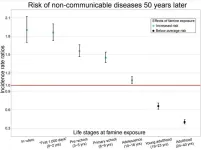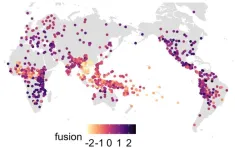The study exemplifies how variable the impacts of even the same tropical cyclone have been, driven differences in by demographic, economic, and social factors. Total excess deaths were particularly high in counties the largest proportion of minorities. Until now, there had been a critical knowledge gap about estimating post-cyclone excess deaths with a consistent methodology from a large-scale study covering the entire United States across multiple decades.
The researchers found that the single largest number of excess deaths was in Orleans Parish, LA, after Hurricane Katrina in 2005, with 719 excess deaths. followed by Harris County, TX, after Hurricane Rita in 2005 (309 excess deaths), Broward County, FL, after Hurricane Matthew in 2016 (185 excess deaths), and Nassau County, NY, after Hurricane Sandy in 2012 (178 excess deaths). Full results of the top-20 most impacted counties and associated year and hurricane can be found in the Table below.
The most estimated excess deaths in a single year were during 2005, with 2,163 estimated post-tropical cyclone excess deaths, with 1,491 from Hurricane Katrina in 2005. Where probabilities of excess deaths were high, 83 percent of post-hurricane-force and 70 percent of post-gale-to-violent-storm-force excess deaths occurred more recently (2004 – 2019); and 94 percent were in more socially vulnerable counties.
“In our study, excess death counts after tropical cyclones were higher more recently and for the most socially vulnerable,” said Robbie M. Parks, PhD, assistant professor of Environmental Health Sciences at Columbia Public Health, and first author. “This was likely in part due to lack of access to adequate short-term transportation, as well as inequitable access to financial resources, education, employment opportunities and timely warnings on tropical cyclone proximity, all of which are results of long-term institutional neglect.”
Knowledge of short-term excess deaths—i.e., the difference between the observed number of deaths in the immediate aftermath post-tropical cyclone and the number of deaths had a cyclone not occurred—is essential for understanding the public health burden of climate-related disasters and a key recommended measure for post-disaster mortality assessment, note the authors.
Following a tropical cyclone, deaths can result from several major causes, including deaths from injuries, infectious and parasitic diseases, cardiovascular diseases, neuropsychiatric conditions, and respiratory diseases. In earlier research published In JAMA and Nature Communications, Parks and colleagues detailed the kinds of causes and risks for death which increased after tropical cyclones.
Using death registration data across four decades and an ensemble of 16 Bayesian statistical models, the researchers estimated the number of excess deaths after tropical cyclones in all impacted areas in the United States including estimates by county, year, tropical cyclone name, and strength of tropical cyclone. Estimated excess deaths in the study were also compared to data from official sources and EM-DAT, the international disaster database.
“Trends of heightened activity and increased intensity of tropical cyclones in recent years indicate that tropical cyclone exposure is and will remain a public health concern,” noted Marianthi-Anna Kioumourtzoglou, ScD, associate professor of Environmental Health Sciences at Columbia Mailman, and senior author. ‘Future research may be able to study associations by smaller areal units -- ZIP Codes, for example --as appropriate exposure and outcome data become available. “It is also essential to prepare for tropical cyclones by accounting for the social determinants of risk and vulnerability of exposed communities, since the most socially vulnerable bear the greatest burden of excess mortality.”
“Our work highlights how deaths are impacted by tropical cyclones, an understudied exposure in relation to public health, and one which will remain an important threat as the climate changes,” observed Parks. As a public health priority, future research should focus on understanding the biological and structural drivers of cyclone-related mortality, how to minimize the number of excess deaths related to tropical cyclones, and the impacts on the scale from years to decades.”
Co-authors are Vasilis Kontis, Ralf Toumi, and Majid Ezzati, Imperial College London; G. Brooke Anderson, Colorado State University; Jane W. Baldwin, University of California, Irvine, and Columbia Lamont-Doherty Earth Observatory; Goodarz Danaei and Francesca Dominici, T. H. Chan School of Public Health, Harvard.
The authors would be happy to work with data visualization teams to produce interactive articles.
Funding was provided by NIH grants K99 ES033742, R00 ES033742, R00 ES022631, R01 S030616, R01 ES028805, R01 ES028033, R01 MD012769, R01 AG066793, R01 ES029950, 5 R01 AG060232, RF1 AG071024, R21 ES028472, P30 ES009089, and P42 ES010349, and the Climate Change Solutions Fund.
Special Note to Reporters: "More information, including a copy of the paper, can be found online at the Science Advances press package at https://www.eurekalert.org/press/vancepak/.
Columbia University Mailman School of Public Health
Founded in 1922, the Columbia University Mailman School of Public Health pursues an agenda of research, education, and service to address the critical and complex public health issues affecting New Yorkers, the nation and the world. The Columbia Mailman School is the fourth largest recipient of NIH grants among schools of public health. Its nearly 300 multi-disciplinary faculty members work in more than 100 countries around the world, addressing such issues as preventing infectious and chronic diseases, environmental health, maternal and child health, health policy, climate change and health, and public health preparedness. It is a leader in public health education with more than 1,300 graduate students from 55 nations pursuing a variety of master’s and doctoral degree programs. The Columbia Mailman School is also home to numerous world-renowned research centers, including ICAP and the Center for Infection and Immunity. For more information, please visit www.publichealth.columbia.edu
Table. Estimated hurricane-specific county excess deaths after top twenty most deadly tropical cyclone events. Values in parentheses after estimated excess death values represent 95% Credible Interval uncertainty. Adapted from Table 2 in Science Advances paper.
Rank
Year
Hurricane name
County
Estimated
excess deaths
1
2005
Katrina
Orleans Parish, LA
719 (685,752)
2
2005
Rita
Harris County, TX
309 (182,429)
3
2016
Matthew
Broward County, FL
185 (86,276)
4
2012
Sandy
Nassau County, NY
178 (67,271)
5
1999
Irene
Broward County, FL
167 (70,258)
6
2017
Irma
Miami-Dade County, FL
147 (2,292)
7
2005
Katrina
Harrison County, MS
141 (126,156)
8
2005
Katrina
St. Bernard, LA
138 (128,148)
9
1992
Andrew
Miami-Dade County, FL
136 (9,249)
10
2017
Irma
Palm Beach County, FL
134 (29,235)
11
2016
Matthew
Miami-Dade County, FL
119 (-20,256)
12
2008
Ike
Harris County, TX
117 (-22,255)
13
2017
Irma
Lee County, FL
106 (49,157)
14
2005
Wilma
Broward County, FL
104 (5,191)
15
2012
Sandy
Richmond County, NY
104 (56,143)
16
1999
Irene
Miami-Dade County, FL
95 (-32,221)
17
2005
Katrina
Miami-Dade County, FL
93 (-29,209)
18
2017
Irma
Pinellas County, FL
84 (-18,179)
19
2012
Sandy
King’s County, NY
84 (-75,220)
20
2017
Irma
Broward County, FL
81 (-20,173)
END




